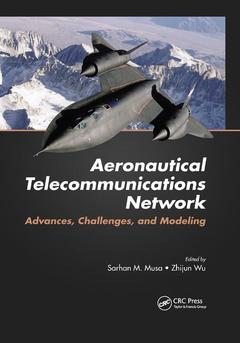Aeronautical Telecommunications Network Advances, Challenges, and Modeling
Coordonnateurs : Musa Sarhan M., Wu Zhijun

Addresses the Challenges of Modern-Day Air Traffic
Air traffic control (ATC) directs aircraft in the sky and on the ground to safety, while the Aeronautical Telecommunications Network (ATN) comprises all systems and phases that assist in aircraft departure and landing. The Aeronautical Telecommunications Network: Advances, Challenges, and Modeling focuses on the development of ATN and examines the role of the various systems that link aircraft with the ground. The book places special emphasis on ATC?introducing the modern ATC system from the perspective of the user and the developer?and provides a thorough understanding of the operating mechanism of the ATC system. It discusses the evolution of ATC, explaining its structure and how it works; includes design examples; and describes all subsystems of the ATC system.
In addition, the book covers relevant tools, techniques, protocols, and architectures in ATN, including MIPv6, air traffic control (ATC), security of air traffic management (ATM), very-high-frequency (VHF) digital link (VDL), aeronautical radio and satellite communications, electromagnetic interference to aeronautical telecommunications, quality of service (QoS)-satisfied ATN routing mechanism speed dynamic environments, and service-oriented architecture (SOA)-based ATN transmission control algorithm. It also incorporates published research and technical reports to illustrate existing problems, highlight current methods and opportunities, and consider future directions and trends.
The authors:
- Provide an overview of ATN
- Illustrate the composition of the ATC system
- Explain how to design an ATC system
- Reveal how to use an ATC system to control in-flight airplanes
- Present the results of author research on spatial mitigation
- Introduce the electromagnetic interference effects and response measures of aviation communications equipment
- Analyze the protective measures of aircraft and ground stations against electromagnetic interference
The Aeronautical Telecommunications Network: Advances, Challenges, and Modeling highlights the advances, challenges, and modeling of ATN, and implements strategies for integrating existing and future data communications networks into a single internetwork serving the aeronautical industry. This book can aid readers in working to ensure the effective management of air traffic and airspace, and the safety of air transport.
Overview of Aeronautical Telecommunication Network. Optimization and Enhancement of MIPv6 in ATN. Modern Air Traffic Control Systems. Security of VHF Data Link in ATM. VDL2 Key Technology and Simulation. GNSS Multipath Interference and Mitigation for UAVs in Urban Canyon Environments. Electromagnetic Interference to Aeronautical Telecommunications. Analysis and Modeling of the QoS Mechanism in ATN. Time Division Multiplexing in Satellite Aeronautical Communications System. ATN Transmission Control Algorithm Based on Service-Oriented Architecture.
Sarhan M. Musa, PhD, is currently an associate professor in the Department of Engineering Technology, Roy G. Perry College of Engineering, at Prairie View A&M University, Texas. He has been director of Prairie View A&M Avaya Networking Academy, Texas, since 2004. Dr. Musa has published more than 100 papers in peer-reviewed journals and conferences. He is a frequent invited speaker, has consulted for organizations around the world, and has written and edited several books. Dr. Musa is a senior member of the Institute of Electrical and Electronics Engineers (IEEE) and is also an LTD Sprint and a Boeing Welliver fellow.
Zhijun Wu
Date de parution : 07-2017
17.8x25.4 cm
Date de parution : 08-2015
17.8x25.4 cm
Thèmes d’Aeronautical Telecommunications Network :
Mots-clés :
Aeronautical Telecommunications Network; Geostationary Earth Orbit; ATN; QoS Routing; Electromagnetic Interference; IPv6 Address; GNSS; FSS Element; Key Technology; IPv6 Node; MIPv6; Mobile IPv6; Mitigation for UAVs; Aeronautical Communication; Modern Air Traffic Control Systems; Synchronous TDM; Multipath Interference; Conical Ring; QoS Mechanism; Mac Sublayer; Service-Oriented Architecture; Mobile IP; Simulation; ATC System; Time Division Multiplexing; D8PSK Modulation; Transmission Control Algorithm; Statistical TDM; Urban Canyon Environments; IPv6 Stack; VDL2; MN’s HoA; VHF Data Link in ATM; FSS; Atm System; ACARS System; Circular Patch; Finite Ground Plane; Multicast Routing; Routing Protocol; Gps Satellite



